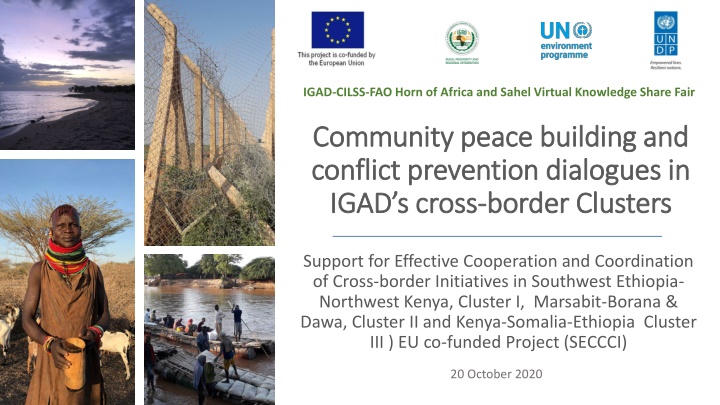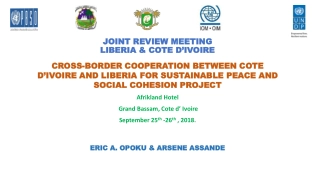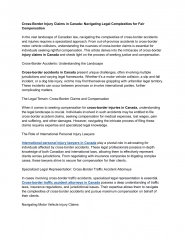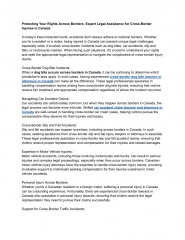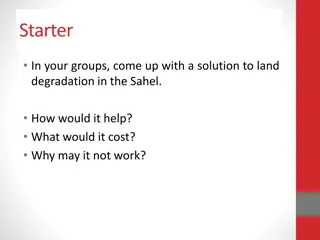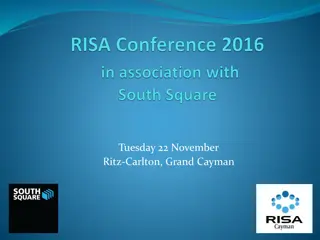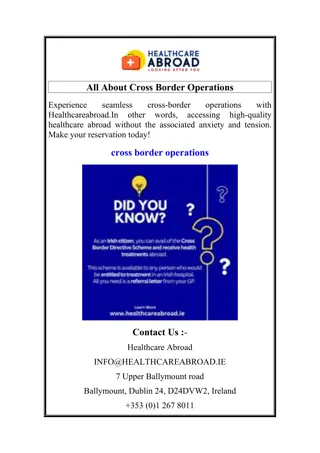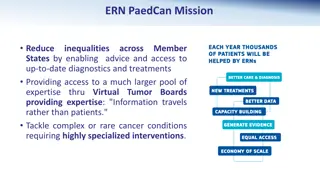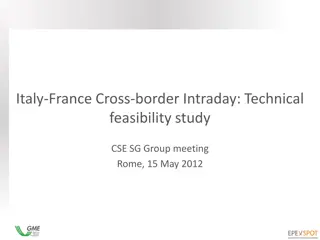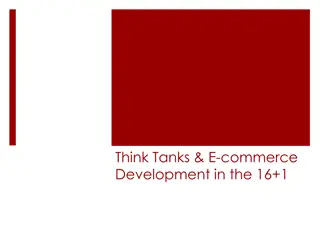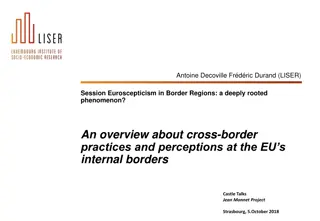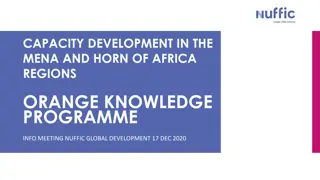Enhancing Cross-Border Cooperation in the Horn of Africa and Sahel
This project aims to support community peace building, conflict prevention dialogues, and effective coordination of cross-border initiatives in the Horn of Africa and Sahel region. It involves multiple stakeholders to address conflict drivers, irregular migration, and displacement. The SECCCI project is co-funded by the EU and focuses on strengthening regional policy frameworks, building community capacities, and ensuring effective cooperation and coordination.
Download Presentation

Please find below an Image/Link to download the presentation.
The content on the website is provided AS IS for your information and personal use only. It may not be sold, licensed, or shared on other websites without obtaining consent from the author.If you encounter any issues during the download, it is possible that the publisher has removed the file from their server.
You are allowed to download the files provided on this website for personal or commercial use, subject to the condition that they are used lawfully. All files are the property of their respective owners.
The content on the website is provided AS IS for your information and personal use only. It may not be sold, licensed, or shared on other websites without obtaining consent from the author.
E N D
Presentation Transcript
IGAD-CILSS-FAO Horn of Africa and Sahel Virtual Knowledge Share Fair Community peace building and Community peace building and conflict prevention dialogues in conflict prevention dialogues in IGAD s cross IGAD s cross- -border Clusters border Clusters Support for Effective Cooperation and Coordination of Cross-border Initiatives in Southwest Ethiopia- Northwest Kenya, Cluster I, Marsabit-Borana & Dawa, Cluster II and Kenya-Somalia-Ethiopia Cluster III ) EU co-funded Project (SECCCI) 20 October 2020
Context Context The SECCCI project (I) Project duration: February 2018 - February 2021 Total resources required: $10,050,311 SECCCI Budget o European Union: EUR 7,706,082, equivalent to USD 9,571,724 o UNDP TRAC: USD 358,940 o UNEP: USD 119,647 European Union UNDP TRAC UNEP
Context Context The SECCCI project (II) The Project is designed to provide technical support to national Governments of Ethiopia, Kenya and Somalia at the national and local level The Overall Objective is to address the drivers of conflict and instability, irregular migration and displacement in the cross-border areas of the Horn of Africa through improved cross-border cooperation and coordination Part of a wider EUTF-financed programme Collaboration in Cross-Border Areas of the Horn of Africa Region .
Support Support for Coordination of Coordination of the Cross for Effective Cooperation and Effective Cooperation and the Cross- -Border Border Initiatives Initiatives SECCCI EU co-funded Project SECCCI EU co-funded Project
Context Context The SECCCI project (III) Specific objectives Specific Objective 1 Specific Objective 2 Specific Objective 3 To strengthen regional policy frameworks, structures and protocols for cross-border cooperation between national and local Governments, the private sector, civil society and international technical and financial partners in development. Capacities of communities, local governments and civil society to fully engage in processes for development planning and results are built. To ensure effective cooperation and coordination, monitoring and evaluation of cross- border initiatives including involvement of relevant national and regional actors in these processes.
Context Context The SECCCI project (IV) Geographic location Turkana Omo at the Kenyan and Ethiopian Border (Cluster I); Marsabit - Moyale at the Kenyan, Ethiopian border (Cluster II); Mandera Gedo Doolow at the Kenyan, Ethiopian and Somalia border (Cluster III).
Context Context The SECCCI project (V) Implementing partners Under the Borderlands Africa Programme,a regional Hub providing knowledge, innovation and programming expertise to governments and partners engaged in development initiatives in the borderlands: quality assurance and the management of SECCCI s implementation. Provides support to governments in transboundary water management. Facilitates Coordination, cooperation and policy dialogues between the member countries involved in implementing the cross-boundary interventions.
Borderlands: Challenges & Opportunities Competition over limited resources, clan power struggle, displacement, discontent and radicalization Climate shocks, marginalization, poor governance, violent conflicts Persistent poverty, exclusion, no prospects, limited employment Besides these vulnerabilities, borderlands should also be seen as a source of opportunity to build up cross-border trade and markets, to ensure regional stability and to promote regional integration and economic development.
The value-added of Cross-border cooperation Maximize synergies and find joint solutions to common challenges; Convert borders into source of opportunity for cross-border trade & markets; Promote stability by fostering networks between local communities, enhancing social cohesion and strengthening local peace structures; Foster community-led peace processes; Facilitate dialogue, trust, understanding for a common border-region identity; Promote regional cooperation and management of transboundary resources. Ensure regional stability, realize socio-economic potential of local communities, achieve improved governance and increased resilience.
Conflict MAP of the Clusters Recurrent conflict incidences Along the IGAD cross-border lands due to political instability and resource scarcity
Implementation and methodology approach Implementation and methodology approach CROSS BORDER INTEGRATED PROGRAM FOR SUSTAINABLE PEACE AND SOCIOECONOMIC TRANSFORMATION: MARSABIT KENYA AND BORENA AND DAWA ZONE ETHIOPIA June 2017 COUNTY,
Strengthening peace structures Government and non-government actors in Ethiopia, Kenya and Somalia have invested considerable efforts to develop formal and informal systems to address conflict and peace issues. SECCCI works with these existing structures to increase their ability to respond to current conflicts and prevent new hotspots from occurring. Specific activities were guided by the communities, with emphasis on important local issues such as contested grazing lands, fishing areas and water resources.
Increasing Social Capital and Cohesion Increasing Social Capital and Cohesion SECCCI works to increase channels of communications between different groups. The project increases the involvement of youth in community decision- making discussions, and creates opportunities for youth from different tribes and areas to socially engage and promote peace ideals with one another. Additionally, the project supports and links women to existing early warning and early response systems to enhance their role as peace builders.
Impacts Impacts As peace building and conflict resolution is a continuous process the project conducted 10 community peace dialogues this year with the participation of 390 participants along the three cluster including men and women. Through Community dialogue, awareness creation on the MoU s and agreements Reduced recurrent resource-based conflicts. Reduced cattle rustling. When it still happens, returning mechanisms were developed without further conflicts. Round table discussions became a frequently adopted process by communities to solve local issues and conflicts.
Conclusion Drivers of conflict should be identified by the participants during the community peace dialogues for a better understanding and to take mitigation measures. (Political, Social and Natural resource based conflicts). The roles of Elders, Women, Youth and Religious leaders in the process of peace building should not be overlooked. The process of community dialogue should respect the diverse views from each participants and should be based on a free dialogue. The relation between the community and the security organ should be strengthened (the most important part in fighting against terrorism and extremism )
Thank You Follow us on @SECCCI_Project
